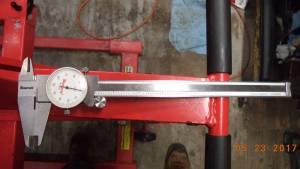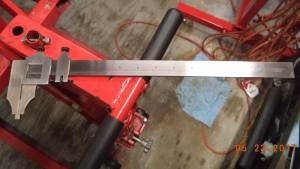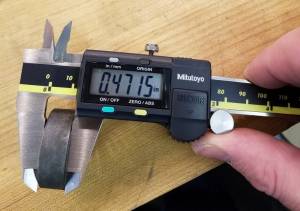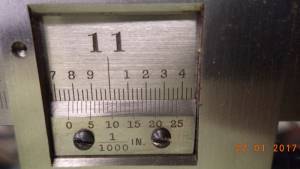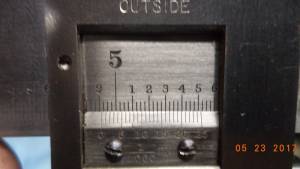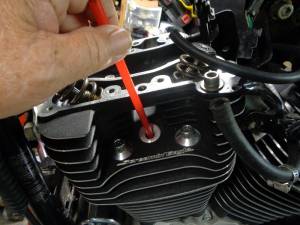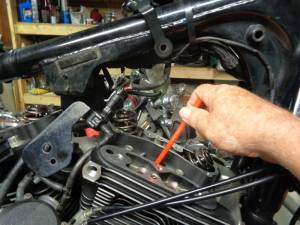Table of Contents
This is an old revision of the document!
REF: Tools - Sub-009
Calipers
- Calipers are precision instruments. That's true enough but not all calipers are calibrated to each other. All calipers also have an accuracy rate based on length of measurement as well. Most manufacturers will post the accuracy rate in the included paperwork with your calipers. For instance, longer measurements will have more of a +/_ accuracy rate than shorter measurements. However, as long as you are using the same caliper for all your measurements, the ensuing differences in measurements are all still relevant. For all manual caliper measurements,
- First pull the jaws apart and snap them back together several times to check for absolute zero every time they snap back. If you have previously set 'zero', most of the time it will not have to be reset unless you set them down roughly or drop them. If they come back to multiple different numbers, chances are there is dirt or debris on the jaws. Oddly enough, if your measurements are in increments of 0.001“, you probably won't see any obstruction but wipe them with a lint free cloth or even your fingers and try again. Failure to clean the jaws will result in wrong measurements or you re-setting the zero mark and your measurements will still be wrong.
- If you have determined 'zero' needs to be re-set on standard dial or electronic calipers, make sure the jaws are clean and are pressed against each other. For manual calipers, loosen the screw holding the faceplate and turn the face to zero, tighten and then snap it back several times to make sure it zeros every time. For digital calipers the procedure is the same except when ready you simply press the 'zero' button. Verniers have no faceplate to re-set.
Reading a caliper
- Open the caliper slightly larger than the piece your measuring, hold the piece against one jaw while pulling the other jaw against your piece. Slightly snug the jaws to the piece and record a reading. Repeat this several times to insure you have a true reading while snapping jaws back to zero before opening them up again.
- Reading Verniers: In the left pic below, a measurement was taken at 10.770”. Read the numbers on the slide rule and add the numbers in the window (which on this model amounts to one thousandth each). As you can see, your watching for the number that matches up with the correct line between the window and the slide rule. The sum of 2 initial readings taken reveals the final reading on this type of caliper. Check the gradients before using to verify (IE metric vs U.S.). In the left pic below, 10.50“ is the closest accurate reading on the slide rule and 0.020” from the window equals 10.770“. Verniers can be used for inside or outside measurements. Outside measurements are taken between the jaws and inside measurements are taken from the outside edge of each jaw. The slide rule gradients are different on each side to accurately show the readings for each choice measurement taken. Notice above the right pic below showing the words 'outside'. The opposite side is marked 'inside'.
Dial Depth Gauge
Application
- This gauge is typically used to check piston height off the deck (piston at TDC and the gauge dropped from the deck). For this application, you'll need one that is accurate to the specs your engine / build requires.
- It can also be used (with dual plug heads) to set true TDC when checking or creating timing marks on the flywheel. For this application, your only using the increments as a guide to which direction the piston is traveling. If your planning on this being a 'one use' tool, it might be better to opt for a cheap one. The probe needs to be about 3” long from the base out though.
Purchasing
- Research for the application needed can save you some time and a lot of money when buying a dial depth gauge. They can be expensive when buying new. Although, some nice used ones will show up on Ebay or other online auctions or stores periodically. You can get them with a fixed single probe end or removable various length ones, increments of .001“ or .0001” or metric versions, different base dimensions / lengths, various throw lengths (total measuring distance) and other variations. Just make sure it is what you think it is or need it to be.
| For versatility, it's nice to have removable probe ends of various lengths. Verify the total throw needed. 4) | Check the dims on your intended work area before purchasing your gauge to verify the probe end is the correct length on the gauge. 5) |
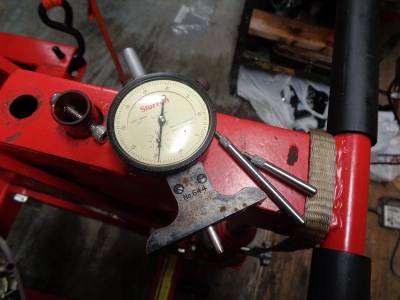 | 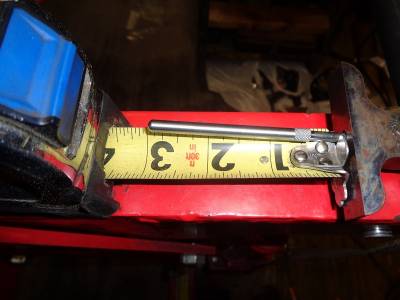 |
Using
- Set the gauge on a clean machined surface or mirror, hold it firmly, loosen the faceplate thumbscrew, turn the faceplate gradients to read '0' and tighten the faceplate thumbscrew. At this point, all measurements will be taken from a 'known base-point' which you just established (0). Place the base on a clean flat surface with the probe hanging off that surface in the middle towards the target. Target is measured as it's distance away from the base as the probe is lowered.
For Finding Piston Top Dead Center (TDC)
With the Head On:
Using a Straw
- You can use a straw through the spark plug hole to measure when the piston is close to TDC with the rocker box on or off. When done, it can only be regarded as an approximate setting however. The piston is only at TDC once for a very short length of time until the rod rolls back over to the down-stroke. It is difficult if near impossible to set exact TDC with a straw. But, unless you are creating a new timing mark or finely setting cam or ignition timing, this is an easy way to accomplish TDC.
- The straw is soft enough that you won't risk breaking anything if it gets squished between the piston and the head.
- For best results, hold the straw loosely while picking up on it periodically to keep it from getting stuck (which will affect your measurements).
- Using a straw with the engine assembled:
- This is best handled with the bike on a lift (or at least the rear tire off the ground) and the transmission in the highest gear while rotating the rear tire in the forward direction.
- Using a straw with the primary and / or gearcase cover(s) off:
- The rear tire doesn't have to be lifted as you can put the transmission in neutral and turn the engine over with the shaft nut on either side.
- It's also best done with two people (one turning the rear tire and one manning the straw). However, it can be done by one person watching the straw rise with the piston and then switching to one hand on the straw and the other nudging the rear tire to feel when the straw goes down.
- Caution: Turning the rear tire while the transmission is engaged will produce up and down movement of the entire bike, make sure it is tied down and secured before attempting to rotate the tire.
With the Head Off
Using a Dial Depth Gauge
| Loosen the thumbscrew to allow you to turn the face (with a slight drag) 8) | Place on a flat clean machined surface or a mirror, turn the face to read “zero”, lock the thumbscrew. 9) | Set the base edges on the flats of the deck and drop the center probe on the piston to measure 'differential' from zero while turning the engine to find TDC 10) |
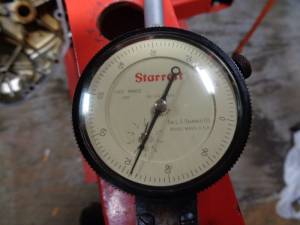 | 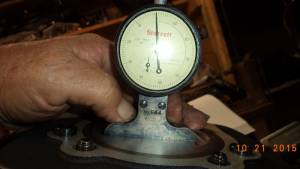 | 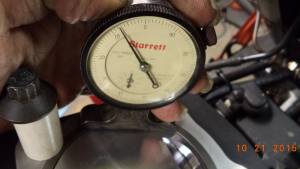 |
| Double check the reading before proceeding | Double check the reading before proceeding |
3)
photo by Screw Loose Dan http://xlforum.net/forums/showthread.php?t=1803692&page=21

